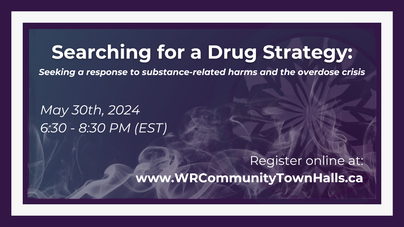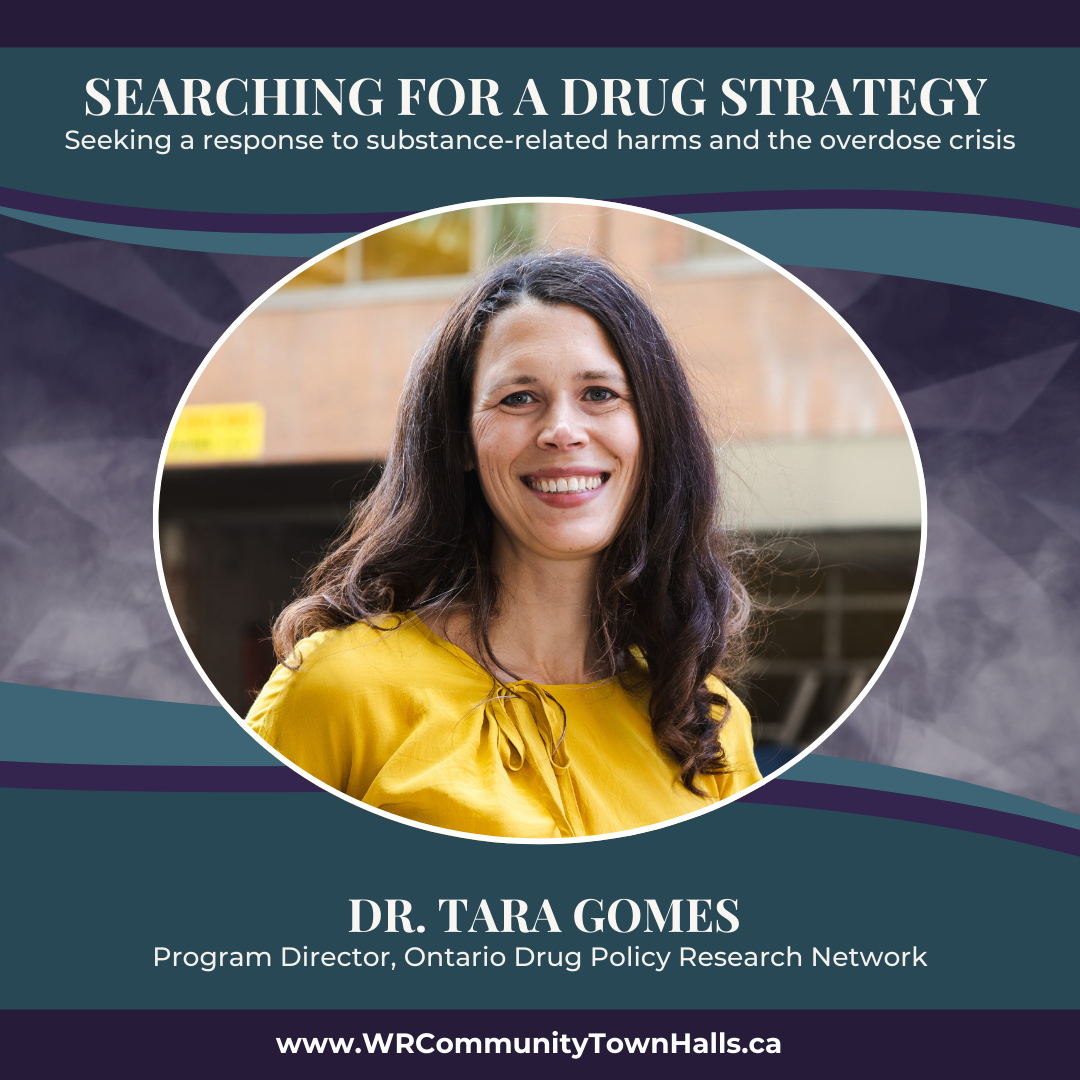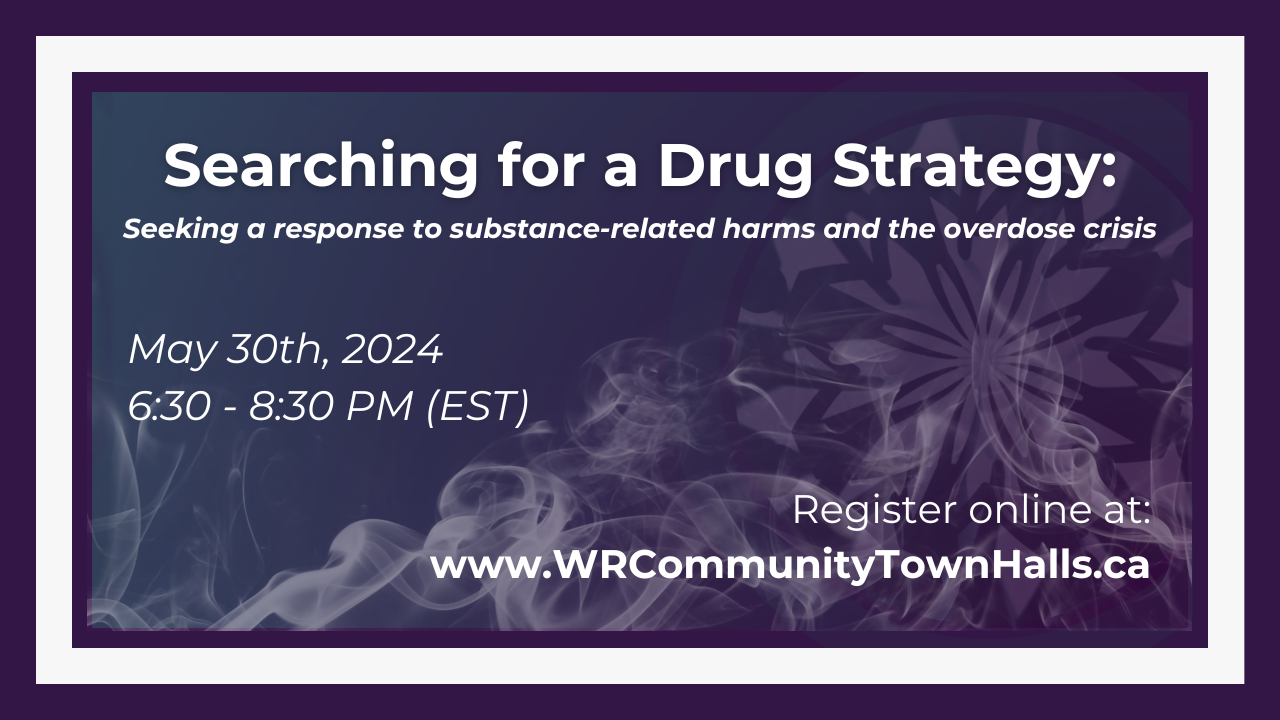Dr. Tara Gomes
Program Director, Ontario Drug Policy Research Network
|
Tara Gomes is the Scientific Director of Urban and Community Health at Unity Health Toronto and holds a Canada Research Chair in Drug Policy and Substance Use. Her research program focuses on drug safety, effectiveness, and policy evaluation, with a specific interest in developing evidence to inform policies that address the ongoing drug toxicity crisis across Canada and that integrate perspectives of impacted communities.
|
Presentation
|
|
View Presentation Slides
|
|
|
On May 30, 2024, a town hall meeting was held to address the escalating opioid crisis and discuss comprehensive strategies involving prevention, treatment, harm reduction, and enforcement. The event featured several distinguished speakers who provided insights based on their expertise and experiences in various aspects of drug policy and public health.
Dr. Tara Gomes underscored the limitations of treatment-focused responses, noting that a significant portion of opioid-related deaths occur among individuals without a diagnosis of opioid use disorder. She called for a broader approach that includes harm reduction, low-barrier treatment options, and culturally appropriate services for vulnerable populations, such as people experiencing homelessness and First Nations communities. This town hall underscored the complexity of the opioid crisis and the necessity of a multifaceted approach involving prevention, harm reduction, treatment, and enforcement. The speakers collectively advocated for evidence-based strategies, comprehensive care, and collaborative efforts to effectively address the crisis and support affected individuals and communities. |
Guest Speakers: |
Beyond Treatment
- Diverse Affected Populations: A significant number of opioid-related deaths occur among individuals without a diagnosis of opioid use disorder, highlighting the need for harm reduction and low-barrier treatment options.
- Need for Culturally Appropriate Services: First Nations people face higher rates of opioid-related deaths, necessitating culturally relevant and accessible services.
- Tailored Community Responses: Responses must be tailored to the unique needs of different communities across Ontario, considering variations in substance use patterns and overdose rates.
Dr. Tara Gomes delivers an in-depth analysis of the opioid crisis in Ontario, focusing on the necessity of diversifying responses beyond traditional treatment. She begins by challenging the prevalent notion that increasing access to treatment alone can resolve the crisis. Gomes highlights that approximately one-third of individuals who succumb to opioid toxicity in Ontario do not have a diagnosed opioid use disorder, meaning they are not eligible for treatment programs designed for addiction. These individuals often use drugs recreationally or occasionally and are significantly impacted by the unpredictable potency of the unregulated drug supply. This reality underscores the need for broader harm reduction strategies that address the immediate risks posed by such a volatile drug environment.
Gomes notes that while about 70,000 people started treatment with medications like methadone and Suboxone last year, 25-33% of these individuals discontinued treatment within the first month. This high dropout rate is due to various reasons, including the rigidity of treatment protocols and personal circumstances. She stresses that traditional treatment does not work for everyone, necessitating the availability of multiple, low-barrier treatment options and comprehensive harm reduction responses.
One of the critical points Gomes emphasizes is the importance of tailored interventions for diverse populations. For instance, people experiencing homelessness are disproportionately affected by opioid toxicity, with one in six opioid-related deaths during the early pandemic occurring within this group. Many of these deaths happened in shelters or temporary housing, highlighting the need for integrated substance use services within housing programs to provide safe drug use environments and immediate intervention capabilities.
First Nations people represent another heavily impacted group, with a higher concentration of opioid-related deaths linked to the historical trauma of colonization and the residential school system. Gomes calls for culturally appropriate, accessible services for First Nations people, both in urban areas and within their communities. She stresses that these services must be sensitive to cultural contexts to be effective.
Gomes also addresses the rising incidence of opioid-related harms among youth and young adults, who face reduced access to treatment and services tailored to their unique needs. This demographic requires innovative approaches that resonate with their preferences and comfort levels.
Moreover, Gomes points out that the opioid crisis affects all regions of Ontario differently. For example, the prevalence of inhalation versus injection, and the types of substances used, vary across the province. She advocates for community-specific strategies to address these variations effectively. This includes developing infrastructure for safer drug consumption spaces that accommodate inhalation, which is increasingly common but often unsupported by existing facilities.
Finally, Gomes calls for unified action across different levels of government and collaboration with researchers. She notes the fragmentation across federal, provincial, and local governments, each with distinct priorities and strategies, as a barrier to cohesive action. By prioritizing evidence-based approaches and setting aside political differences, a more effective and comprehensive response to the opioid crisis can be developed.
Gomes notes that while about 70,000 people started treatment with medications like methadone and Suboxone last year, 25-33% of these individuals discontinued treatment within the first month. This high dropout rate is due to various reasons, including the rigidity of treatment protocols and personal circumstances. She stresses that traditional treatment does not work for everyone, necessitating the availability of multiple, low-barrier treatment options and comprehensive harm reduction responses.
One of the critical points Gomes emphasizes is the importance of tailored interventions for diverse populations. For instance, people experiencing homelessness are disproportionately affected by opioid toxicity, with one in six opioid-related deaths during the early pandemic occurring within this group. Many of these deaths happened in shelters or temporary housing, highlighting the need for integrated substance use services within housing programs to provide safe drug use environments and immediate intervention capabilities.
First Nations people represent another heavily impacted group, with a higher concentration of opioid-related deaths linked to the historical trauma of colonization and the residential school system. Gomes calls for culturally appropriate, accessible services for First Nations people, both in urban areas and within their communities. She stresses that these services must be sensitive to cultural contexts to be effective.
Gomes also addresses the rising incidence of opioid-related harms among youth and young adults, who face reduced access to treatment and services tailored to their unique needs. This demographic requires innovative approaches that resonate with their preferences and comfort levels.
Moreover, Gomes points out that the opioid crisis affects all regions of Ontario differently. For example, the prevalence of inhalation versus injection, and the types of substances used, vary across the province. She advocates for community-specific strategies to address these variations effectively. This includes developing infrastructure for safer drug consumption spaces that accommodate inhalation, which is increasingly common but often unsupported by existing facilities.
Finally, Gomes calls for unified action across different levels of government and collaboration with researchers. She notes the fragmentation across federal, provincial, and local governments, each with distinct priorities and strategies, as a barrier to cohesive action. By prioritizing evidence-based approaches and setting aside political differences, a more effective and comprehensive response to the opioid crisis can be developed.



